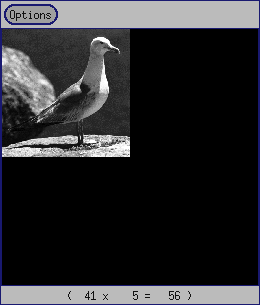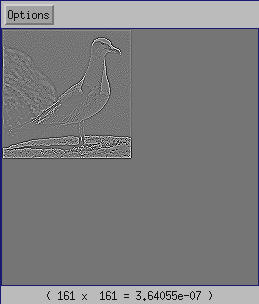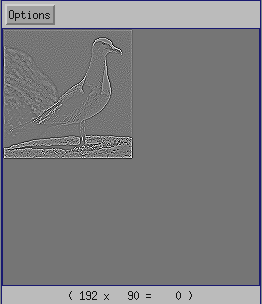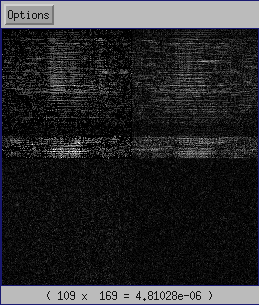

In the discrete world we are somewhat limited to periodic functions. Thus, the period (length of a data record) of a function plays an important role if aliasisng or wraparound errors are to be avoided. If circular convolution is sought then no further processing is needed. But if linear convolution is sought then the functions need to be extended (zero padded) in order to avoid wraparound errors. What is the new size?
If image1 is AxB and image2 is CxD then: a) if M = A + C - 1, periods in the width direction are adjacent if N = B + D - 1, periods in the height direction are adjacent b) if M > A + C - 1, periods in the width direction will be separated if N > B + D - 1, periods in the height direction will be separated c) if M < A + C - 1, periods in the width direction will overlap if N < B + D - 1, periods in the height direction will overlap

The size of the original image "gull.kdf" is 256x256, and the size of the convolution kernel, Laplacian filter, is 3x3. This filter highlights details with a high frequency content, like edges. The Laplacian filter (other names are: window, mask, template, kernel) is depicted below, and is an ascii file with its origin or "sweet spot" at its center.
# # Laplacian High-pass filter # 0.0 -1.0 0.0 -1.0 4.0 -1.0 0.0 -1.0 0.0
In order to perform Linear convolution between the original image and filter kernel, we must first determine new size to avoid the wraparound effect. One choice for a set of new size is:
M (new width) = 256 + 3 -1 = 258 N (new height) = 256 + 3 -1 = 258
The difficulty with the new size is that we cannot take advantage of the FFT to perform linear convolution. This is true because both the new width and height are not an integer power of two. We can zeropad both image and kernel to the next higher power of two, that is, 512x512, and then use the FFT to perform linear convolution.
In our experiment, we are going to follow this approach but first we are going to reduce or "shrink" the original image to 1/2 its size, i.e., 128x128. The reasoning behind this is to speed up the computations necessary. The reduced original image, and zero padded to 256x256 is shown below.

|
|---|
The results of the filtering operation in the frequency domain and in the spatial domain are depicted below. In addition, the difference of both results is also shown.

|

|
|---|---|
| a) | b) |
The difference of the results yields

|
|---|
Observe that the difference image shows the existance of very small pixel values. These small pixel values are due to roundoff and truncation errors that appear when there is a limited number of bits to represent values.